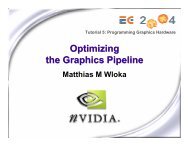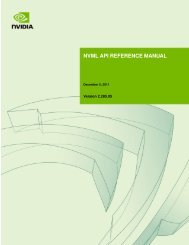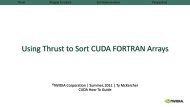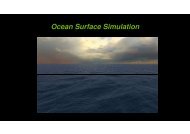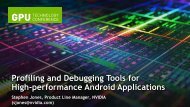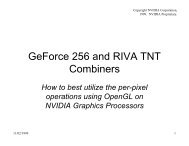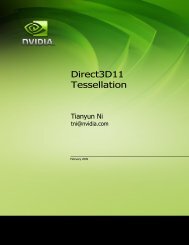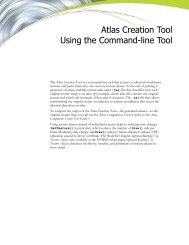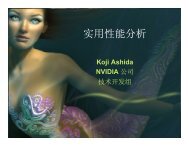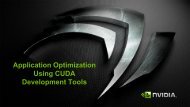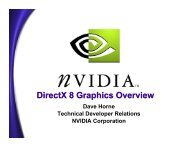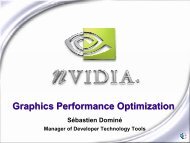OpenGL ES 2.0 Development for the Tegra Platform - NVIDIA ...
OpenGL ES 2.0 Development for the Tegra Platform - NVIDIA ...
OpenGL ES 2.0 Development for the Tegra Platform - NVIDIA ...
- No tags were found...
Create successful ePaper yourself
Turn your PDF publications into a flip-book with our unique Google optimized e-Paper software.
<strong>OpenGL</strong> <strong>ES</strong> <strong>2.0</strong> <strong>Development</strong> <strong>for</strong> <strong>the</strong><strong>Tegra</strong> Plat<strong>for</strong>mVersion 111128.01March 2012- 1 -
ContentsINTRODUCTION 3SHADER DEVELOPMENT 4EGL DEVELOPMENT NOT<strong>ES</strong> 4TEGRA OPENGL <strong>ES</strong> LIMITS 6TEGRA-SUPPORTED OPENGL <strong>ES</strong> <strong>2.0</strong> EXTENSIONS 7March 2012 - 2 -
IntroductionThis documentation provides plat<strong>for</strong>m-specific details <strong>for</strong> developing shader-based <strong>OpenGL</strong> <strong>ES</strong><strong>2.0</strong> (GL<strong>ES</strong>2) applications on <strong>the</strong> <strong>Tegra</strong> plat<strong>for</strong>m. The in<strong>for</strong>mation in this documentation isdesigned to be OS-independent, and represents <strong>the</strong> capabilities of <strong>the</strong> <strong>Tegra</strong> <strong>OpenGL</strong> <strong>ES</strong> <strong>2.0</strong>hardware and driver on all supported operating systems.This document does not detail per<strong>for</strong>mance optimizations; it only covers rendering feature- andcompatibility-related items. Per<strong>for</strong>mance optimizations <strong>for</strong> <strong>Tegra</strong> are described in o<strong>the</strong>rdocumentation that may be available from <strong>the</strong> <strong>Tegra</strong> Developers’ site.March 2012 - 3 -
Shader <strong>Development</strong>This section provides guidelines and details of shader development on <strong>the</strong> <strong>Tegra</strong> plat<strong>for</strong>m. Itdiscusses specific shader features and limitations on <strong>the</strong> <strong>Tegra</strong>.GLSL-<strong>ES</strong> ShadersThe <strong>Tegra</strong> supports <strong>OpenGL</strong> <strong>ES</strong> <strong>2.0</strong> and its shading language, GLSL-<strong>ES</strong>. Basically a subset ofdesktop GLSL, GLSL-<strong>ES</strong> removes all of <strong>the</strong> fixed-function language constructs, and alsoremoves language constructs <strong>for</strong> GL features that are not a part of <strong>OpenGL</strong> <strong>ES</strong> <strong>2.0</strong> core, such as1D and 3D textures.General GLSL-<strong>ES</strong> features and uses are outside <strong>the</strong> scope of this document. Developers shouldrefer directly to <strong>the</strong> GLSL specification, which is currently downloadable from <strong>the</strong> Khronosgroup website:http://www.khronos.org/registry/gles/specs/<strong>2.0</strong>/GLSL_<strong>ES</strong>_Specification_1.0.14.pdfSource versus Binary ShadersEarlier versions of <strong>the</strong> <strong>Tegra</strong> <strong>OpenGL</strong> <strong>ES</strong> drivers supported ei<strong>the</strong>r source code or precompiledbinary shaders, as <strong>the</strong> shader compilers on <strong>the</strong> plat<strong>for</strong>m matured. However, <strong>the</strong> many benefitsof source code shaders on <strong>the</strong> plat<strong>for</strong>m, especially multiple commercial plat<strong>for</strong>ms nowoutweigh <strong>the</strong> previous benefits and current issues with precompiled shaders. Only source codeshaders are supported in <strong>the</strong> current <strong>Tegra</strong> drivers. Some drivers may still export <strong>the</strong> legacyGL_NV_plat<strong>for</strong>m_binary, however binary shaders should be considered deprecated and <strong>the</strong>iruse is not recommended.Loading ShadersShaders are loaded using <strong>the</strong> <strong>OpenGL</strong> <strong>ES</strong> standard functions: glShaderSource,glCompileShader, and glLinkProgram.EGL <strong>Development</strong> NotesEGL ConfigurationsSearching <strong>the</strong> Returned ListEGL’s method of sorting configurations returned from queries is often counter-intuitive.Applications using eglChooseConfig must not simply select <strong>the</strong> first returned configuration,March 2012 - 4 -
nor should <strong>the</strong>y request only one configuration. An example of a common and confusing caseis requesting a 565 RGB configuration. Owing to section 3.4 of <strong>the</strong> EGL spec,eglChooseConfig must return <strong>the</strong> deepest color buffer first, even if it is deeper than <strong>the</strong>requested <strong>for</strong>mat, and even if <strong>the</strong> requested <strong>for</strong>mat could have been matched exactly. In o<strong>the</strong>rwords, an implementation that supports 565 and 8888 must return 8888 earlier in <strong>the</strong> list than565, even if 565 is requested. The EGL spec notes <strong>the</strong> following in a footnote to 3.4:“This rule places configs with deeper color buffers first in <strong>the</strong> list returned byeglChooseConfig. Applications may find this counterintuitive, and need toper<strong>for</strong>m additional processing on <strong>the</strong> list of configs to find one best matching<strong>the</strong>ir requirements. For example, specifying RGBA depths of 5651 could returna list whose first config has a depth of 8888.”Applications should always request an array of multiple configurations, and should queryimportant attributes such as red, green and blue depths of each, per<strong>for</strong>ming <strong>the</strong>ir own manualsorting and filtering of <strong>the</strong> resulting array. EGL’s behavior is defined by <strong>the</strong> spec; <strong>Tegra</strong>’s drivercannot deviate from <strong>the</strong> proscribed order.32-bit versus 24-bit<strong>Tegra</strong> does not support rendering to 24-bit “888” buffers. Applications wishing to use such<strong>for</strong>mats should request a RGBA8888 <strong>for</strong>mat to ensure that <strong>the</strong> OS does not return a SWemulatedconfiguration. Requesting 24-bit RGB888 with <strong>OpenGL</strong> <strong>ES</strong>1.x on Android can lead toa SW-rendered configuration and decreased per<strong>for</strong>mance and available features.March 2012 - 5 -
<strong>Tegra</strong> <strong>OpenGL</strong> <strong>ES</strong> LimitsThe following table lists <strong>the</strong> current limits of various <strong>OpenGL</strong> <strong>ES</strong> <strong>2.0</strong> values as returned by <strong>the</strong>driver. Note that <strong>the</strong>se are intended as guidelines – applications should always queryimportant values from <strong>the</strong> particular driver being used.GL_SUBPIXEL_BITS 4GL_ALIASED_POINT_SIZE_RANGE (1, 256)GL_ALIASED_LINE_WIDTH_RANGE (1, 256)GL_MAX_ARRAY_TEXTURE_LAYERS_EXT 2048GL_MAX_CUBE_MAP_TEXTURE_SIZE 2048GL_MAX_TEXTURE_SIZE 2048GL_MAX_TEXTURE_MAX_ANISOTROPY_EXT 15GL_MAX_VIEWPORT_DIMS (3839, 3839)GL_NUM_COMPR<strong>ES</strong>SED_TEXTURE_FORMATS 9GL_NUM_SHADER_BINARY_FORMATS0 (may export 1, but use ofGL_SHADER_BINARY_FORMATSGL_MAX_VERTEX_ATTRIBS 16GL_MAX_VERTEX_UNIFORM_VECTORS 256GL_MAX_VERTEX_TEXTURE_IMAGE_UNITS 0GL_MAX_VARYING_VECTORS 15GL_MAX_TEXTURE_IMAGE_UNITS 16GL_MAX_FRAGMENT_UNIFORM_VECTORS 1024GL_MAX_COMBINED_TEXTURE_IMAGE_UNITS 16GL_MAX_COLOR_ATTACHMENTS_NV 8GL_MAX_RENDERBUFFER_SIZE 3839GL_MAX_DRAW_BUFFERS_ARB 8binary shaders is notrecommended)(may exportGL_NV_plat<strong>for</strong>m_binary, butuse of binary shaders is notrecommended)March 2012 - 6 -
<strong>Tegra</strong>-Supported <strong>OpenGL</strong> <strong>ES</strong> <strong>2.0</strong> ExtensionsExtension support in EGL and GL<strong>ES</strong> differs on a device-by-device and OS-by-OS basis on<strong>Tegra</strong>. Applications should always query <strong>for</strong> extension support on <strong>the</strong> target plat<strong>for</strong>m. Some of<strong>the</strong> Khronos-general GL<strong>ES</strong> extensions supported on most <strong>Tegra</strong> plat<strong>for</strong>ms include <strong>the</strong>following. The specifications <strong>for</strong> <strong>the</strong>se extensions may be found athttp://www.khronos.org/registry/gles/GL_EXT_packed_floatGL_O<strong>ES</strong>_mapbufferGL_O<strong>ES</strong>_vertex_half_floatGL_O<strong>ES</strong>_EGL_imageGL_O<strong>ES</strong>_EGL_image_externalGL_O<strong>ES</strong>_EGL_syncGL_O<strong>ES</strong>_fbo_render_mipmapGL_O<strong>ES</strong>_rgb8_rgba8GL_EXT_bgraGL_EXT_texture_compression_dxt1GL_EXT_texture_compression_latcGL_EXT_texture_compression_s3tcGL_EXT_texture_<strong>for</strong>mat_BGRA8888GL_O<strong>ES</strong>_compressed_ETC1_RGB8_textureGL_O<strong>ES</strong>_texture_floatVertex and Geometry ExtensionsRGB floating-point textures in one 32bpp <strong>for</strong>matLow-overhead buffer updates16-bit float vertex support (1 sign bit, 5 exponentbits, 10 mantissa bits)FBO and Renderbuffer ExtensionsCross-API imagesCross-API imagesCommand-stream synchronizationMipmap-level FBO support24 and 32bpp FBOsTexture Format ExtensionsReversed RGBA texture supportDXT1 texture supportLA compressed texturesDXT3/5 texture supportReversed RGBA texture supportETC1 texturesNote that 32-bit floating point textures are accepted,but are converted to 16-bit floating point texturesinternally, and thus use of this extension is notrecommendedGL_O<strong>ES</strong>_texture_half_float16-bit (1 sign bit, 5 exponent bits, 10 mantissa bits)Texture Feature ExtensionsGL_EXT_texture_filter_anisotropic Anisotropic mipmap filteringGL_EXT_texture_array1D arrays of 2D texturesGL_EXT_unpack_subimageLimited stride support <strong>for</strong> texture updatesGL_EXT_occlusion_query_booleanMarch 2012 - 7 -
The list below highlights some of <strong>the</strong> NV-specific extensions and <strong>the</strong> links to <strong>the</strong>ir specificationsin <strong>the</strong> Khronos registry. Several of <strong>the</strong>se extensions do not yet appear in <strong>the</strong> registry; <strong>the</strong> specs<strong>for</strong> <strong>the</strong>se extensions are included at <strong>the</strong> end of <strong>the</strong> chapter.EGL_NV_system_timeGL_NV_coverage_sampleGL_NV_depth_nonlinearGL_NV_draw_buffersGL_NV_draw_pathGL_NV_fbo_color_attachmentsGL_NV_plat<strong>for</strong>m_binaryGL_NV_read_bufferGL_NV_read_depthGL_NV_read_stencilGL_NV_shader_framebuffer_fetchGL_NV_texture_compression_s3tc_updateGL_NV_texture_npot_2D_mipmaphttp://www.khronos.org/registry/egl/extensions/NV/EGL_NV_system_time.txthttp://www.khronos.org/registry/gles/extensions/NV/EGL_NV_coverage_sample.txthttp://www.khronos.org/registry/gles/extensions/NV/EGL_NV_depth_nonlinear.txthttp://www.khronos.org/registry/gles/extensions/NV/GL_NV_draw_buffers.txtDocumented at <strong>the</strong> end of <strong>the</strong> chapterhttp://www.khronos.org/registry/gles/extensions/NV/GL_NV_fbo_color_attachments.txtDeprecated; use source-code shadershttp://www.khronos.org/registry/gles/extensions/NV/GL_NV_read_buffer.txthttp://www.khronos.org/registry/gles/extensions/NV/GL_NV_read_depth_stencil.txthttp://www.khronos.org/registry/gles/extensions/NV/GL_NV_read_depth_stencil.txtDocumented at <strong>the</strong> end of <strong>the</strong> chapterhttp://www.khronos.org/registry/gles/extensions/NV/GL_NV_texture_compression_s3tc_update.txthttp://www.khronos.org/registry/gles/extensions/NV/GL_NV_texture_npot_2D_mipmap.txtO<strong>the</strong>r Extension SpecsThe following extensions specs are not yet in <strong>the</strong> Khronos registry site. They are included at <strong>the</strong>end of this chapter.GL_NV_draw_pathGL_NV_shader_framebuffer_fetchMarch 2012 - 8 -
NV_draw_pathNameNV_draw_pathName StringsContactGL_NV_draw_pathJussi Rasanen, <strong>NVIDIA</strong> Corporation (jrasanen 'at' nvidia.com)Tero Karras, <strong>NVIDIA</strong> Corporation (tkarras 'at' nvidia.com)NoticeStatusVersionNumberCopyright <strong>NVIDIA</strong> Corporation, 2008<strong>NVIDIA</strong> ProprietaryLast Modified: 2008/09/16<strong>NVIDIA</strong> Revision: 0.11XXXX Not Yet XXXXDependenciesWritten based on <strong>the</strong> wording of <strong>the</strong> <strong>OpenGL</strong> <strong>2.0</strong> Specification.Requires <strong>OpenGL</strong>-<strong>ES</strong> <strong>2.0</strong>.OverviewThis extension adds functionality to render planar Bezier paths. Use cases<strong>for</strong> this extension include acceleration of vector graphics content andtext rendering.A path is defined as a number of segments, representing ei<strong>the</strong>r straightlines, or quadratic or cubic Bezier curves, and can be ei<strong>the</strong>r filled orstroked. Filling corresponds to generating <strong>the</strong> fragments that lie within<strong>the</strong> interior of <strong>the</strong> path. Stroking corresponds to generating <strong>the</strong> fragmentsthat lie within a region defined by sweeping a straight-line pen along <strong>the</strong>path.Path segments are specified using a command array and a vertex coordinatearray. When a path is drawn, <strong>the</strong> command array is processed sequentially.There are two categories of commands: ones that cause a path segment to bedrawn, and ones that affect how path is rendered. Depending on its type,each command consumes a variable number of coordinates from <strong>the</strong> vertexcoordinate array.When filling a path, <strong>the</strong> order in which <strong>the</strong> path segments are specified isdisregarded. The only requirement is that <strong>the</strong>y <strong>for</strong>m zero or more closedMarch 2012 - 9 -
contours. If a path contains unclosed contours, its interior and thus <strong>the</strong>resulting set of fragments is undefined.The contours of a path may have self-intersecting geometry and overlapwith each o<strong>the</strong>r. For such paths, <strong>the</strong> interior is determined using a fillrule. Two fill rules, even-odd and non-zero, are provided. The directionof path segments matters only with <strong>the</strong> non-zero fill rule, as explainedbelow.When stroking a path, additional cap and join styles may be applied at<strong>the</strong> start and end of path segments. Joins are automatically generatedbetween pairs of segments whose corresponding commands are adjacent. Capsare generated based on explicit path commands.Rendering quality can be controlled per path by specifying <strong>the</strong> maximumdeviation from <strong>the</strong> ideal curve in window space.Path rendering pipelineThe path rendering pipeline consists of three stages: trans<strong>for</strong>mation andtexture coordinate generation, fill and stroke rasterization, and fragmentshader. This extension provides a minimal fixed function trans<strong>for</strong>mationand texture coordinate generation stage. Programmable vertex shaders arenot supported in <strong>the</strong> context of path rendering.Path definitionPaths are defined as a combination of an immutable sequence of commandsand an associated mutable sequence of vertex coordinates. Each commandconsumes zero or more vertex coordinates. Path commands are represented asunsigned bytes, whereas <strong>the</strong> data type of <strong>the</strong> vertex coordinates isspecified separately <strong>for</strong> each path. Path vertices are alwaystwo-dimensional.The following table lists <strong>the</strong> available path commands:+------------------------+--------+--------------------------------------+| Path command | Coords | Notes |+------------------------+--------+--------------------------------------+| MOVE_TO_NV | 2 | Change <strong>the</strong> current position || LINE_TO_NV | 2 | Draw a straight line || QUADRATIC_BEZIER_TO_NV | 4 | Draw a quadratic Bezier curve || CUBIC_BEZIER_TO_NV | 6 | Draw a cubic Bezier curve || START_MARKER_NV | 0 | Record <strong>the</strong> current position || CLOSE_NV | 0 | Draw line to <strong>the</strong> recorded position || STROKE_CAP0_NV | 0 | Use cap style 0 in adjacent segment || STROKE_CAP1_NV | 0 | Use cap style 1 in adjacent segment || STROKE_CAP2_NV | 0 | Use cap style 2 in adjacent segment || STROKE_CAP3_NV | 0 | Use cap style 3 in adjacent segment |+------------------------+--------+--------------------------------------+Trans<strong>for</strong>mation and texture coordinate generationPath vertices specified by <strong>the</strong> vertex coordinate sequence are converted to<strong>the</strong> homogenous <strong>for</strong>m (x, y, 0, 1) by <strong>the</strong> trans<strong>for</strong>mation stage, and <strong>the</strong>ntrans<strong>for</strong>med from model space to clip space using <strong>the</strong>MATRIX_PATH_TO_CLIP_NV matrix.To facilitate texture mapping and color gradients, <strong>the</strong> path vertices arealso trans<strong>for</strong>med using each of <strong>the</strong> MATRIX_PATH_COORD[0-3]_NV matrices. AMarch 2012 - 10 -
uilt-in fragment shader varying array gl_PathCoord of type vec4 receives<strong>the</strong> corresponding interpolated values. The number of elements in <strong>the</strong>gl_PathCoord array is 4. Although gradients and texture coordinates canalso be implemented using <strong>the</strong> gl_FragCoord built-in fragment shadervariable, it is generally more efficient to use gl_PathCoord, avoidingunnecessary per-fragment matrix multiplications.MATRIX_PATH_COORD[0-3]_NV and MATRIX_PATH_TO_CLIP_NV can define ahomogenous perspective trans<strong>for</strong>mation. It is up to <strong>the</strong> fragment shaderto normalize <strong>the</strong> interpolated coordinates if necessary.Filling a pathWhen filling a path, <strong>the</strong> path segments must <strong>for</strong>m zero or more closedcontours. If any of <strong>the</strong> contours are left open, <strong>the</strong> resulting set offragments is undefined. This requirement can be rephrased as follows,depending on <strong>the</strong> value of FILL_RULE_NV:NON_ZERO_NV:Each two-dimensional point has an equal number of path segmentsstarting and ending at it.EVEN_ODD_NVEach two-dimensional point has an even number of path segmentsstarting or ending at it.Note that <strong>for</strong> any two points to be considered identical, <strong>the</strong> binaryrepresentations of <strong>the</strong>ir coordinates must match exactly.To determine <strong>the</strong> segments to draw, <strong>the</strong> path commands are processedsequentially. The following temporary values are maintained during <strong>the</strong>process:i: Current vertex coordinate index, initially 0.cp: Current position, initially (0, 0).sp: Start position, initially undefined.Each path command is processed depending on its type as follows. c[i] isused to denote <strong>the</strong> i'th value in <strong>the</strong> vertex coordinate array.MOVE_TO_NV:Replace <strong>the</strong> current position.cp = (c[i+0], c[i+1]), i += 2.LINE_TO_NV:Draw a straight line from to (c[i+0], c[i+1]).cp = (c[i+0], c[i+1]), i += 2.QUADRATIC_BEZIER_TO_NV:Draw a quadratic Bezier curve from to (c[i+2], c[i+3]) using(c[i+0], c[i+1]) as <strong>the</strong> control point.cp = (c[i+2], c[i+3]), i += 4.CUBIC_BEZIER_TO_NV:Draw a cubic Bezier curve from to (c[i+4], c[i+5]) using(c[i+0], c[i+1]) and (c[i+2], c[i+3]) as <strong>the</strong> control points.cp = (c[i+4], c[i+5]), i += 6.START_MARKER_NV:Replace <strong>the</strong> start position.March 2012 - 11 -
sp = cp.CLOSE_NV:If is undefined, ignore <strong>the</strong> command.O<strong>the</strong>rwise, draw a straight line from to .cp = sp.STROKE_CAP[0-3]_NV:Ignore <strong>the</strong> command.START_MARKER_NV and CLOSE_NV commands can be used to implement subpathclosure found in many vector graphics content <strong>for</strong>mats. For filled paths,an explicit LINE_TO_NV command to <strong>the</strong> start position will produce <strong>the</strong> sameresult as CLOSE_NV. For stroked paths, <strong>the</strong> difference is that CLOSE_NVwill join <strong>the</strong> closing line segment to <strong>the</strong> segment following<strong>the</strong> START_MARKER_NV command.A fill rule is applied to determine if any given point is contained within<strong>the</strong> interior of <strong>the</strong> path. The fill rules are defined by projecting a rayfrom <strong>the</strong> point in question to infinity and counting <strong>the</strong> intersections of<strong>the</strong> ray and path segments. When looking along <strong>the</strong> direction of <strong>the</strong> ray,segments intersecting from left to right increment <strong>the</strong> counter and rightto left segment intersections decrement <strong>the</strong> counter. If <strong>the</strong> fill rule isNON_ZERO_NV, <strong>the</strong> point is within <strong>the</strong> interior if <strong>the</strong> final count isnon-zero. If <strong>the</strong> fill rule is EVEN_ODD_NV, <strong>the</strong> point is within <strong>the</strong>interior if <strong>the</strong> final count is odd. The counter must support at least 255intersections. For more complex paths, <strong>the</strong> results are undefined.Curves may be approximated within a limit specified by <strong>the</strong> PATH_QUALITY_NVparameter. The limit defines <strong>the</strong> radius of a disc in <strong>the</strong> window space.Placing <strong>the</strong> disc at each sampling point, <strong>the</strong> following rules are used todetermine whe<strong>the</strong>r to generate <strong>the</strong> corresponding fragments:* If <strong>the</strong> disc is entirely inside <strong>the</strong> path, generate a fragment.* If <strong>the</strong> disc is entirely outside <strong>the</strong> path, do not generate a fragment.* If <strong>the</strong> disc is partially inside <strong>the</strong> path, whe<strong>the</strong>r to generate a fragmentis up to <strong>the</strong> implementation.Stroking a pathStroking is per<strong>for</strong>med by sweeping a straight-line pen along each pathsegment, generating fragments <strong>for</strong> <strong>the</strong> sampling points touched by <strong>the</strong> pen.Additionally, cap and join styles may be applied at <strong>the</strong> start and end of<strong>the</strong> segments.Cap and join styles are selected <strong>for</strong> each path segment based on <strong>the</strong> pathcommands adjacent to <strong>the</strong> one specifying <strong>the</strong> segment, and <strong>the</strong> values of <strong>the</strong>path parameters. The general rule is that <strong>the</strong> end of a segment is joinedto start of <strong>the</strong> following segment if <strong>the</strong>y are specified by adjacent pathcommands. If <strong>the</strong> start or end of a segment is not joined, a cap isgenerated instead.Fill rule is not applied when stroking. Instead, a fragment is generated<strong>for</strong> each sampling point inside <strong>the</strong> stroke. Even in case <strong>the</strong> stroke sweepsover a sampling point multiple times, only one fragment is generated.Dashing is not supported directly. Instead, this extension allowsimplementing dashing in user code by generating <strong>the</strong> corresponding.Paths are stroked in a coordinate space distinct from <strong>the</strong> path user spaceMarch 2012 - 12 -
and <strong>the</strong> clip space. The trans<strong>for</strong>mation from <strong>the</strong> stroke space to <strong>the</strong> pathuser space is is controlled by <strong>the</strong> MATRIX_STROKE_TO_PATH_NV matrix. Both<strong>the</strong> path user space and <strong>the</strong> stroke space are two-dimensional, and thusonly <strong>the</strong> 2x2 upper-left components of <strong>the</strong> matrix are used.Conceptually, stroking a path consists of five steps. First, <strong>the</strong> pathsegments are trans<strong>for</strong>med from <strong>the</strong> path user space to <strong>the</strong> stroke spaceusing <strong>the</strong> inverse of <strong>the</strong> stroke-to-path matrix. Second, <strong>the</strong> set of pointsaffected by <strong>the</strong> stroke is determined in <strong>the</strong> stroke space, using astraight-line pen that extends one unit into each direction. Third, <strong>the</strong>set of points is trans<strong>for</strong>med from <strong>the</strong> stroke space back to <strong>the</strong> path userspace using <strong>the</strong> stroke-to-path matrix. Fourth, <strong>the</strong> points are fur<strong>the</strong>rtrans<strong>for</strong>med from <strong>the</strong> path user space to <strong>the</strong> clip space using <strong>the</strong>path-to-clip matrix. Fifth, a fragment is generated <strong>for</strong> each samplingpoint contained by <strong>the</strong> set of trans<strong>for</strong>med points.The stroke-to-path matrix allows specifying stroke width independent ofhow <strong>the</strong> path itself is trans<strong>for</strong>med. Two common scenarios include scalingstroke, where <strong>the</strong> stroke width varies as <strong>the</strong> path-to-clip trans<strong>for</strong>mationchanges, and non-scaling stroke, where <strong>the</strong> width remains constant in <strong>the</strong>clip space. For scaling stroke, <strong>the</strong> stroke-to-path matrix should bespecified as an identity matrix multiplied by half of <strong>the</strong> desired strokewidth in <strong>the</strong> path user space. For non-scaling stroke, it should bespecified as <strong>the</strong> inverse of <strong>the</strong> path-to-clip matrix multiplied by half of<strong>the</strong> stroke width in <strong>the</strong> clip space.The style of all joins is determined by <strong>the</strong> STROKE_JOIN_STYLE_NV pathparameter, which can be set to one of <strong>the</strong> following values:JOIN_MITER_NV:Extend <strong>the</strong> incoming and outgoing stroke outlines until <strong>the</strong>y intersect.If <strong>the</strong> distance between <strong>the</strong> intersection point and <strong>the</strong> center pointexceeds STROKE_MITER_LIMIT_NV in <strong>the</strong> stroke space, apply a bevel joininstead.JOIN_ROUND_NV:Connect <strong>the</strong> incoming and outgoing stroke outlines with a circular arcsegment in <strong>the</strong> stroke space, corresponding to a radius of one unit.JOIN_BEVEL_NV:Connect <strong>the</strong> incoming and outgoing stroke outlines with a straightline.JOIN_CLIPPED_MITER_NV:Same as JOIN_MITER_NV if STROKE_MITER_LIMIT_NV is not exceeded.O<strong>the</strong>rwise, clip <strong>the</strong> extended outlines and connect <strong>the</strong>m with a straightline. The clipping is done against a line whose distance from <strong>the</strong>center point is equal to STROKE_MITER_LIMIT_NV in <strong>the</strong> stroke space,and whose orientation is symmetrical with regards to <strong>the</strong> outlines.The style of a start cap depends on <strong>the</strong> previous path command, and <strong>the</strong>style of an end cap depends on <strong>the</strong> next command. If <strong>the</strong> command is notSTROKE_CAP[0-3]_NV, <strong>the</strong> cap style is STROKE_CAP_BUTT_NV. O<strong>the</strong>rwise, <strong>the</strong>style is determined by <strong>the</strong> corresponding STROKE_CAP[0-3]_STYLE_NV pathparameter, each opf which can be set to one of <strong>the</strong> following values:CAP_BUTT_NV:Terminate <strong>the</strong> segment with a straight line connecting <strong>the</strong> twooutline endpoints.March 2012 - 13 -
CAP_ROUND_NV:Terminate <strong>the</strong> segment with a semicircle with radius equal to one in<strong>the</strong> stroke space.CAP_SQUARE_NV:Terminate <strong>the</strong> segment with a rectangle extending one unit along <strong>the</strong>path tangent.CAP_TRIANGLE_NV:Terminate <strong>the</strong> segment with a triangle with two vertices at <strong>the</strong> strokeoutline endpoints, and a third vertex one unit along <strong>the</strong> path tangent.As with fill, <strong>the</strong> path commands are processed sequentially, maintaining<strong>the</strong> following temporary values:i: Current vertex coordinate index, initially 0.cp: Current position, initially (0, 0).ct: Current tangent, initially undefined.cs: Pending cap style, initially butt.sp: Start position, initially undefined.st: Start tangent, initially undefined.Each command is processed as follows, depending on its type:MOVE_TO_NV:* If is defined, draw a butt end cap at .* cp = (c[i+0], c[i+1]), ct = undefined, cs = butt, i += 2.LINE_TO_NV, QUADRATIC_BEZIER_TO_NV, and CUBIC_BEZIER_TO_NV:* Draw <strong>the</strong> segment corresponding to <strong>the</strong> command type.* If is undefined, draw a start cap of style at .* If is defined, draw a join at between and <strong>the</strong> starttangent of <strong>the</strong> segment.* If <strong>the</strong> previous command is START_MARKER_NV, replace with <strong>the</strong>start tangent of <strong>the</strong> segment.* cp = end point, ct = end tangent, i += num.START_MARKER_NV:* If is defined, draw a butt end cap at .* ct = undefined, cs = butt, sp = cp, st = undefined.CLOSE_NV:* If is undefined, ignore <strong>the</strong> command.* Draw a straight line from to .* If is undefined, draw a start cap of style at .* If is defined, draw a join at between and <strong>the</strong>direction of <strong>the</strong> line.* If is undefined, draw a butt end cap at .* If is defined, draw a join at sp between <strong>the</strong> direction of <strong>the</strong>line and .* cp = sp, ct = undefined, cs = butt.STROKE_CAP[0-3]_NV:* If is defined, draw an end cap of <strong>the</strong> specified style.* ct = undefined, cs = style specified by <strong>the</strong> command.Path programsPaths are drawn using a special type of program object called a pathprogram. Path programs function like normal program objects, except thatMarch 2012 - 14 -
<strong>the</strong>y do not allow a vertex shader to be specified. Path programs arecreated with a new function CreatePathProgramNV().Fragment shaderFragment shader depth values are obtained by trans<strong>for</strong>ming <strong>the</strong> homogenousvertex coordinates (x, y, 0, 1) into <strong>the</strong> clip space. This enables mixing3D and path geometry using depth buffering.Since path programs do not support vertex shaders, path fragment shaderscannot make use of user-defined varyings. Instead, this extension addsbuilt-in variables gl_PathCoord[0-3] of type vec4 that receiveinterpolated vertex positions trans<strong>for</strong>med with <strong>the</strong>ir respectiveMATRIX_PATH_COORD[0-3]_NV matrices.The value of gl_FrontFacing is undefined when rendering paths.The rest of <strong>the</strong> pipelineWhen rendering paths, stencil functionality and backface culling are notapplied. Blending, di<strong>the</strong>ring, depth test, scissor test, polygon offset,and multisampling are applied as with o<strong>the</strong>r primitives.Even though stencil test and operation are unavailable when renderingpaths, <strong>the</strong> original contents of <strong>the</strong> stencil buffer are retained.Path buffersPath buffers facilitate efficient rendering of animated text or o<strong>the</strong>rinstanced path geometry by making it possible to render multiple pathobjects with a single draw call. A path buffer contains a list of pathobject handles and associated translation vectors.Invariance rulesChanging path parameters, viewport, trans<strong>for</strong>mations and clippingparameters may result in a different set of pixels to be rendered.New Procedures and Functionsuint CreatePathNV(enum datatype,sizei numCommands,const ubyte* commands );void DeletePathNV( uint path );void PathVerticesNV(void PathParameterfNV(void PathParameteriNV(uint path,const void* vertices );uint path,enum paramType,float param );uint path,enum paramType,int param );uint CreatePathProgramNV( void );void PathMatrixNV(enum target,March 2012 - 15 -
const float* value );void DrawPathNV(uint path,enum mode );uint CreatePathbufferNV( sizei capacity );void DeletePathbufferNV( uint buffer );void PathbufferPathNV(uint buffer,int index,uint path );void PathbufferPositionNV( uint buffer,int index,float x,float y );void DrawPathbufferNV(uint buffer,enum mode );New TypesNoneNew TokensAccepted as <strong>the</strong> parameter of PathParameterNV:PATH_QUALITY_NVFILL_RULE_NVSTROKE_CAP0_STYLE_NVSTROKE_CAP1_STYLE_NVSTROKE_CAP2_STYLE_NVSTROKE_CAP3_STYLE_NVSTROKE_JOIN_STYLE_NVSTROKE_MITER_LIMIT_NV0x8ED80x8ED90x8EE00x8EE10x8EE20x8EE30x8EE80x8EE9Values <strong>for</strong> <strong>the</strong> ILL_RULE_NV path parameter:EVEN_ODD_NVNON_ZERO_NV0x8EF00x8EF1Values <strong>for</strong> <strong>the</strong> CAP[0-3]_STYLE_NV path parameter:CAP_BUTT_NVCAP_ROUND_NVCAP_SQUARE_NVCAP_TRIANGLE_NV0x8EF40x8EF50x8EF60x8EF7Values <strong>for</strong> <strong>the</strong> JOIN_STYLE_NV path parameter:JOIN_MITER_NVJOIN_ROUND_NVJOIN_BEVEL_NVJOIN_CLIPPED_MITER_NV0x8EFC0x8EFD0x8EFE0x8EFFAccepted as <strong>the</strong> parameter of PathMatrixNV:MATRIX_PATH_TO_CLIP_NV0x8F04March 2012 - 16 -
MATRIX_STROKE_TO_PATH_NV 0x8F05MATRIX_PATH_COORD0_NV 0x8F08MATRIX_PATH_COORD1_NV 0x8F09MATRIX_PATH_COORD2_NV 0x8F0AMATRIX_PATH_COORD3_NV 0x8F0BAccepted as <strong>the</strong> parameter of DrawPathbufferNV:FILL_PATH_NVSTROKE_PATH_NV0x8F180x8F19Accepted as path commands by CreatePathNV:MOVE_TO_NVLINE_TO_NVQUADRATIC_BEZIER_TO_NVCUBIC_BEZIER_TO_NVSTART_MARKER_NVCLOSE_NVSTROKE_CAP0_NVSTROKE_CAP1_NVSTROKE_CAP2_NVSTROKE_CAP3_NV0x000x010x020x030x200x210x400x410x420x43Additions to Chapter 2 of <strong>the</strong> <strong>OpenGL</strong> <strong>ES</strong> SpecificationAdd <strong>the</strong> following error conditions to Chapter 2.8, under DrawArrays:"An INVALID_OPERATION error is generated if <strong>the</strong> current program is a pathprogram."Add <strong>the</strong> following error conditions to Chapter 2.8, under DrawElements:"An INVALID_OPERATION error is generated if <strong>the</strong> current program is a pathprogram."Add <strong>the</strong> following error conditions to Chapter 2.15, under AttachShader."An INVALID_OPERATION error is generated if <strong>the</strong> program is a path programand <strong>the</strong> shader is a vertex shader."Add <strong>the</strong> following error conditions to Chapter 2.15, under LinkProgram."Linking a program without a vertex shader will not fail if <strong>the</strong> program isa path program."Additions to Chapter 3 of <strong>the</strong> <strong>OpenGL</strong> <strong>ES</strong> SpecificationAdd a new section between sections 3.5 (Polygons) and 3.6 (PixelRectangles)"3.6 PathsThis extension adds a new type of primitive, paths, to <strong>OpenGL</strong> <strong>ES</strong>'primitives - points, lines, polygons, pixel rectangles and bitmaps.3.6.1 Path objectsNew path objects are created with <strong>the</strong> callMarch 2012 - 17 -
uint CreatePathNV( enum datatype,sizei numCommands,const ubyte* commands );where is <strong>the</strong> vertex data type and it must be one of[UNSIGNED_]BYTE, [UNSIGNED_]SHORT, [UNSIGNED_]INT, FLOAT, FIXED, is <strong>the</strong> number of commands in <strong>the</strong> path definition and is a pointer to an unsigned byte array of commands. Validcommands are listed below. The function returns a non-zero handle to <strong>the</strong>object or 0 on error.An INVALID_ENUM error is generated if is not one of <strong>the</strong> valuesspecified above. An INVALID_VALUE error is generated if isless than zero or is greater than zero and isNULL or <strong>the</strong> array contains an invalid command.TODO note that path objects can be shared between multiple contextsPath objects are deleted with <strong>the</strong> commandvoid DeletePathNV( uint path );where is <strong>the</strong> handle to <strong>the</strong> path object to delete. If <strong>the</strong> path isassigned to one or more path buffers, path resources are freed only when<strong>the</strong> last reference to <strong>the</strong> path is removed. Path handle is invalid after acall to DeletePathNV. An INVALID_VALUE error is generated if <strong>the</strong> pathobject does not exist.Path vertices are specified with <strong>the</strong> commandvoid PathVerticesNV( uint path,const void* vertices );where is <strong>the</strong> handle to <strong>the</strong> path object and is a pointerto an array of vertices. must contain at least as manycoordinate tuples as is consumed by <strong>the</strong> associated path commands,o<strong>the</strong>rwise <strong>the</strong> results are undefined, and may lead to a program crash. If contains more coordinates than consumed by <strong>the</strong> path commands,<strong>the</strong> rest are silently ignored.An INVALID_VALUE error is generated if <strong>the</strong> specified object doesnot exist or if is NULL and <strong>the</strong> path command requires vertices.Path parameters are set using <strong>the</strong> commandsvoid PathParameterfNV( uint path,enum paramType,float param );void PathParameteriNV( uint path,enum paramType,int param );where is <strong>the</strong> path object handle, is <strong>the</strong> parameter toset and is <strong>the</strong> value of <strong>the</strong> parameter.The following symbols are accepted as :PATH_QUALITY_NVMaximum allowed deviation from <strong>the</strong> ideal path measured in pixels. TheMarch 2012 - 18 -
default value is 0.5 pixels.FILL_RULE_NVFill rule to use <strong>for</strong> filling paths. must be ei<strong>the</strong>rEVEN_ODD_NV or NON_ZERO_NV. The default value is EVEN_ODD_NV.STROKE_CAPn_STYLE_NVcap style <strong>for</strong> <strong>the</strong> cap index n used when stroking a path. The defaultvalues are CAP_BUTT_NV.STROKE_JOIN_STYLE_NVjoin style used when stroking a path. The default value isJOIN_MITER_NV.STROKE_MITER_LIMIT_NVmiter limit used when stroking a path with miter joins. If a joinangle exceeds <strong>the</strong> limit, a miter join is converted into a bevel join.The default value is 4.If paramType is PATH_QUALITY_NV in PathParameteriNV(), param is convertedto a float. If paramType is not PATH_QUALITY_NV in PathParameterfNV(),param is converted to an int.An INVALID_VALUE error is generated if <strong>the</strong> object does not exist.An INVALID_ENUM error is generated if is not any of <strong>the</strong> above.An INVALID_VALUE error is generated if is PATH_QUALITY_NV and
An INVALID_VALUE error is generated if <strong>the</strong> does not exist. AnINVALID_OPERATION error is generated if <strong>the</strong>re is no current program, <strong>the</strong>current program is not a path program, stencil test is enabled, polygonmode is not GL_FILL, or shade model is not GL_SMOOTH. An INVALID_ENUM isgenerated if is not FILL_PATH_NV or STROKE_PATH_NV.3.6.2 Path programsA path program is a special type of program object that o<strong>the</strong>rwise behaveslike a normal program object, but allows attaching only a fragment shader.Path programs are created using <strong>the</strong> commanduint CreatePathProgramNV( void );The function returns 0 on error (i.e. OUT_OF_MEMORY).TODO describe LinkProgram error conditions here <strong>for</strong> clarity?3.6.3 Path buffersPath buffers can be used <strong>for</strong> efficiently rendering multiple instances of aset of path objects with a single draw call. Each path in a path bufferhas an associated position vector that allows specifying a model spaceposition offset <strong>for</strong> that path. Path buffers are created using <strong>the</strong> functionuint CreatePathbufferNV( sizei capacity );where is <strong>the</strong> number of paths in a path buffer. This functionreturns a non-zero handle to a path buffer object or 0 on error.An INVALID_VALUE error is generated if capacity < 0.TODO note that path buffer objects can be shared between multiple contextsPath buffers are deleted using <strong>the</strong> callvoid DeletePathbufferNV( uint buffer );where is <strong>the</strong> handle to <strong>the</strong> path buffer. Path buffer handle isinvalid after a call to DeletePathbufferNV.An INVALID_VALUE error is generated if <strong>the</strong> path buffer does not exist.A path can be added to or removed from a path buffer with <strong>the</strong> functionvoid PathbufferPathNV( uint buffer,int index,uint path );where is <strong>the</strong> path buffer object handle, is <strong>the</strong> index of<strong>the</strong> path buffer slot and is <strong>the</strong> path object handle. Path bufferpaths are mutable and can be re-specified later. Calling PathbufferPathNVwith set to zero removes path from <strong>the</strong> path buffer and leaves <strong>the</strong>slot corresponding to empty.An INVALID_VALUE error is generated if <strong>the</strong> path buffer object does not exist, or is less than zero, or greater than or equal to<strong>the</strong> path buffer capacity.Path buffer path position vector is specified using <strong>the</strong> callMarch 2012 - 20 -
void PathbufferPositionNV( uint buffer,int index,float x,float y );where is <strong>the</strong> path buffer object handle, is <strong>the</strong> index of<strong>the</strong> path buffer slot and and specify <strong>the</strong> translation. Path bufferpath translations are mutable and can be re-specified later.An INVALID_VALUE error is generated if <strong>the</strong> path buffer does not exist orindex < 0 or index >= path buffer capacity.All paths in a path buffer are rendered using <strong>the</strong> commandvoid DrawPathbufferNV( uint buffer,enum mode );An INVALID_VALUE error is generated if does not exist. AnINVALID_OPERATION error is generated if <strong>the</strong>re is no current program, <strong>the</strong>current program is not a path program, stencil test is enabled, polygonmode is not GL_FILL, or shade model is not GL_SMOOTH. An INVALID_ENUM isgenerated if is not FILL_PATH_NV or STROKE_PATH_NV. The effect of aDrawPathbufferNV call is <strong>the</strong> same as if DrawPathNV was called <strong>for</strong> eachindividual path reference in <strong>the</strong> path buffer, ordered from <strong>the</strong> first indexto <strong>the</strong> last."Add <strong>the</strong> following to Chapter 3.11 in <strong>the</strong> section Shader Inputs."The value of gl_FrontFacing is undefined if <strong>the</strong> current program is a pathprogram.""If <strong>the</strong> current program is a path program and fragment shader has definedvarying variables gl_PathCoord[0-3], <strong>the</strong>y will recieve interpolated vertexcoordinates trans<strong>for</strong>med with <strong>the</strong>ir respective MATRIX_PATH_COORD[0-3]_NV".Additions to Chapter 4 of <strong>the</strong> <strong>OpenGL</strong> <strong>ES</strong> SpecificationIssuesAdd <strong>the</strong> following to <strong>the</strong> end of Chapter 4.1.5 Stencil Test."Stencil functionality is not applied when rendering paths. Path renderingwill generate an error if stencil testing is enabled."1. Should we use vertex shader or fixed function trans<strong>for</strong>m?R<strong>ES</strong>OLUTION: Introduce minimal fixed function trans<strong>for</strong>m and texgenfunctionality.DISCUSSION: The problem with vertex shader is that it allows changingvertex/control point positions arbitrarily, but path geometry onlymakes sense if it remains planar. A similar problem occurs with vertexattributes: since attributes of three vertices define interpolation ona plane, <strong>the</strong> attributes of <strong>the</strong> rest of <strong>the</strong> vertices cannot be chosenfreely <strong>for</strong> <strong>the</strong> interpolation to remain well-defined. In effect, this<strong>for</strong>ces vertex attributes to be derived from vertex positions, which canbe described by a matrix multiplication. Fur<strong>the</strong>rmore, manyimplementations are expected to cache <strong>the</strong> results of flattening and/ortriangulation, which is much simpler in case of fixed functionMarch 2012 - 21 -
trans<strong>for</strong>m.Downsides to using fixed function trans<strong>for</strong>mation include <strong>the</strong> lack ofsupport <strong>for</strong> morphing. We expect most content to not use morphing, so aviable alternative is modifying <strong>the</strong> path coordinates. Ano<strong>the</strong>r downsideis that we're reintroducing fixed function trans<strong>for</strong>m stage into <strong>ES</strong>2. Inour opinion, <strong>the</strong> downsides of adopting vertex shader solution outweighthis concern.2. Should we leverage VBOs/vertex arrays <strong>for</strong> path coordinates andcommands?R<strong>ES</strong>OLUTION: Involving VBOs would make <strong>the</strong> extension much messier.3. Should we have elliptical arc segments?R<strong>ES</strong>OLUTION: Not in this version. It is fairly straight<strong>for</strong>ward toconvert arcs into quadratic beziers in an application when content isloaded.4. Should we have vertex indices?R<strong>ES</strong>OLUTION: No. This would unnecessarily complicate <strong>the</strong> API.5. Should we use 1 - 4 component vectors as vertex position?R<strong>ES</strong>OLUTION: No. It is not clear how non-planar geometry would berendered.6. Should we support perspective trans<strong>for</strong>mations?R<strong>ES</strong>OLUTION: Yes.7. Should we support stroking?R<strong>ES</strong>OLUTION: Yes, all vector graphics <strong>for</strong>mats have stroking. Stroking isa ra<strong>the</strong>r involved process both implementation-wise and computationally,so it is a good candidate <strong>for</strong> being implemented in a driver.8. Should we allow modification of paths?R<strong>ES</strong>OLUTION: Modifying coordinates is needed <strong>for</strong> animation, especiallysince we ignore vertex shader. There is no good use case <strong>for</strong> modifyingcommands.9. What happens in case a contour is not closed?R<strong>ES</strong>OLUTION: The result is undefined. Alternatively we could have anerror check, but that is an extra burden <strong>for</strong> implementations and extrawork in <strong>the</strong> common case where <strong>the</strong> path data is ok.10. Should we support edge antialiasing?R<strong>ES</strong>OLUTION: No. <strong>ES</strong>2 doesn't support edge antialiasing <strong>for</strong> o<strong>the</strong>rprimitives ei<strong>the</strong>r, and this extension is compatible with multisampling.11. What invariance requirements should we impose?SUGG<strong>ES</strong>TION:1) Rendering <strong>the</strong> same path with <strong>the</strong> same state must generate <strong>the</strong> sameMarch 2012 - 22 -
pixels. This is <strong>the</strong> normal GL invariance requirement.2) If two adjoining paths have a shared curve defined by exactly <strong>the</strong>same vertices (bitwise exact), <strong>the</strong>re can be no gaps. The curvedirection can change and <strong>the</strong> invariant must still hold.3) UNR<strong>ES</strong>OLVED: If two paths have a shared curve, plus one of <strong>the</strong> pathshas extra geometry that intersects <strong>the</strong> shared curve, does <strong>the</strong>no-gap requirement still have to hold? This is problematic <strong>for</strong>implementations that generate extra vertices at intersection pointsin <strong>the</strong> process of triangulation/path simplification.Revision History#0.11 - 2008/09/16 - Tero Karras#0.10 - 2008/09/15 - Tero Karras#0.9 - 2008/09/12 - Jussi RasanenMarch 2012 - 23 -
NV_shader_framebuffer_fetchNameNV_shader_framebuffer_fetchName StringsContactNoticeStatusVersionNumberGL_NV_shader_framebuffer_fetchGary King, <strong>NVIDIA</strong> Corporation (gking 'at' nvidia.com)Copyright <strong>NVIDIA</strong> Corporation, 2005 - 2006<strong>NVIDIA</strong> ProprietaryLast Modified: 2006/04/28<strong>NVIDIA</strong> Revision: 0.9XXXX Not Yet XXXXDependenciesThis extension is written against <strong>the</strong> <strong>OpenGL</strong>-<strong>ES</strong> Shading Language1.10 Specification.OverviewIssuesThis extension provides a mechanism whereby a fragment shaderwritten in <strong>the</strong> <strong>OpenGL</strong>-<strong>ES</strong> Shading Language (GLSL-<strong>ES</strong>) may use<strong>the</strong> color values stored in <strong>the</strong> active draw buffers aswell-defined input values.1. How should this functionality be exposed?R<strong>ES</strong>OLVED: Four options were considered <strong>for</strong> this functionality:A) Defining reads from gl_FragColor and gl_FragData (priorto any writes) to result in <strong>the</strong> existing framebuffervalues.B) Defining new read-only built-in variables correspondingto <strong>the</strong> existing framebuffer data (e.g., gl_LastFragColor).C) Defining new built-in functions which return <strong>the</strong> existingframebuffer data.March 2012 - 24 -
D) Defining a new programmable stage (e.g., a Sample Shader)which takes <strong>the</strong> fragment shader output values and<strong>the</strong> existing framebuffer data as inputs.This extension has chosen option B, as it provides <strong>the</strong> best mix oflanguage / API simplicity and programmer flexibility. Reusing<strong>the</strong> existing built-in variables (option (A)) unnecessarilycomplicates <strong>the</strong> language, since it requires shader compilers toper<strong>for</strong>m flow analysis to determine whe<strong>the</strong>r or not framebuffer loadsare required. Option (C) requires adding ei<strong>the</strong>r multiple entrypoints (one <strong>for</strong> each gl_FragData array entry), or also addingkeywords to specify which buffer should be read. Option (D) isinteresting, but leads to a variety of questions regarding whatfunctionality should be included in <strong>the</strong> new stage (e.g., "shouldtexturing be included?") There<strong>for</strong>e, Option B has been chosendue to its comparative simplicity and available functionality.2. What value should gl_LastFragColor contain when <strong>the</strong>ARB_draw_buffers extension is in use?R<strong>ES</strong>OLVED: Two options were considered <strong>for</strong> this functionality:A) To mirror ARB_draw_buffers specification <strong>the</strong> value ingl_LastFragColor should be dependent on all activedraw buffers.B) The value on gl_LastFragColor should be <strong>the</strong> same as <strong>the</strong> onein gl_LastFragData[0].This extension has chosen option B, <strong>for</strong> its simplicity. OptionA may follow <strong>the</strong> spirit of <strong>the</strong> original ARB_draw_buffersspecification more closely but <strong>the</strong> value of gl_LastFragData becomessomewhat undefined. There is no good way to combine <strong>the</strong> valuesfrom multiple draw buffers.New Functions and Entry PointsNoneNew Builtin Variablesmediump vec4 gl_LastFragData[gl_MaxDrawBuffers]mediump vec4 gl_LastFragColorChanges to <strong>the</strong> <strong>OpenGL</strong>-<strong>ES</strong> Shading Language 1.10 Specification, Chapter 7Add after <strong>the</strong> last sentence of Paragraph 2 of Section 7.2, FragmentShader Special Variables ("These variables may be written to more [...]":"... To access <strong>the</strong> existing framebuffer values (e.g., to implementa complex blend operation inside <strong>the</strong> shader), fragment shadersshould use <strong>the</strong> read-only input values gl_LastFragColor andgl_LastFragData."Insert new paragraph after Paragraph 7 of Section 7.2 ("If a shaderstatically assigns [...]")"Similarly, if a shader using <strong>the</strong> NV_shader_framebuffer_fetch extensionMarch 2012 - 25 -
statically assigns a value to gl_FragColor, it may not read any elementof gl_LastFragData. If a shader using <strong>the</strong> NV_shader_framebuffer_fetchextension statically writes a value to any element of gl_FragData, itmay not read from gl_LastFragColor. That is, use of <strong>the</strong> inputs definedin <strong>the</strong> NV_shader_framebuffer_fetch extension must mirror <strong>the</strong> outputsused in <strong>the</strong> shader program."March 2012 - 26 -
NoticeALL <strong>NVIDIA</strong> D<strong>ES</strong>IGN SPECIFICATIONS, REFERENCE BOARDS, FIL<strong>ES</strong>, DRAWINGS, DIAGNOSTICS, LISTS, AND OTHERDOCUMENTS (TOGETHER AND SEPARATELY, “MATERIALS”) ARE BEING PROVIDED “AS IS.” <strong>NVIDIA</strong> MAK<strong>ES</strong> NO WARRANTI<strong>ES</strong>,EXPR<strong>ES</strong>SED, IMPLIED, STATUTORY, OR OTHERWISE WITH R<strong>ES</strong>PECT TO THE MATERIALS, AND EXPR<strong>ES</strong>SLY DISCLAIMS ALLIMPLIED WARRANTI<strong>ES</strong> OF NONINFRINGEMENT, MERCHANTABILITY, AND FITN<strong>ES</strong>S FOR A PARTICULAR PURPOSE.In<strong>for</strong>mation furnished is believed to be accurate and reliable. However, <strong>NVIDIA</strong> Corporation assumes no responsibility <strong>for</strong> <strong>the</strong>consequences of use of such in<strong>for</strong>mation or <strong>for</strong> any infringement of patents or o<strong>the</strong>r rights of third parties that may result fromits use. No license is granted by implication or o<strong>the</strong>rwise under any patent or patent rights of <strong>NVIDIA</strong> Corporation.Specifications mentioned in this publication are subject to change without notice. This publication supersedes and replaces allin<strong>for</strong>mation previously supplied. <strong>NVIDIA</strong> Corporation products are not authorized <strong>for</strong> use as critical components in life supportdevices or systems without express written approval of <strong>NVIDIA</strong> Corporation.Trademarks<strong>NVIDIA</strong>, <strong>the</strong> <strong>NVIDIA</strong> logo, <strong>Tegra</strong>, GeForce, <strong>NVIDIA</strong> Quadro, and <strong>NVIDIA</strong> CUDA are trademarks or registeredtrademarks of <strong>NVIDIA</strong> Corporation in <strong>the</strong> United States and o<strong>the</strong>r countries. O<strong>the</strong>r company and productnames may be trademarks of <strong>the</strong> respective companies with which <strong>the</strong>y are associated.Copyright© 2008-2011 <strong>NVIDIA</strong> Corporation. All rights reserved.<strong>NVIDIA</strong> Corporation2701 San Tomas ExpresswaySanta Clara, CA 95050www.nvidia.com



